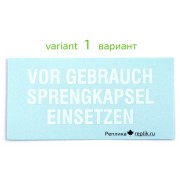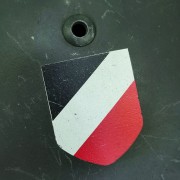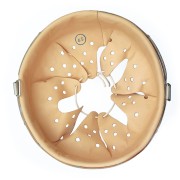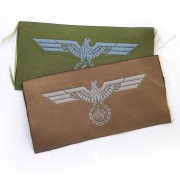Description
The price is for 1 (one) shield, not for a pair (not for a set). The buyer collects the kit independently, buying the necessary number of shields.
To see additional photos please follow the link.
We offer high-quality copies of the original patterns, produced exclusively for our store. Our decals are an independent development based on original designs. The decals have the accurate proportions, they are printed on professional equipment.
The decals are artificially aged, that is, the white color is yellowish, and there are already scratches and chips on the image. Such decals are well suited for reenactment, so that they do not look new as from the factory. They are also good for film production.
How to install the decal? Put a piece of paper with the image (as it is, do not cut anything) in warm water for 30-60 seconds. If there are advertising elements on the decal (logo or frame), they are easily removed (with fingers) when the substrate is wet. After that, the decal must be put on the surface of the helmet and, holding the image with your finger, pull the paper base out. Set the pattern evenly, wetting it with water if it sticks. You can pre-mark the surface of the helmet using a pencil, where the corners of the picture should be. Then remove the water from under the picture with a rag or toilet paper, holding the image with your fingers, so as not to move.
How to fasten the decal? The decal keeps perfectly by itself and does not require fastening. However, if you are going to wear a helmet during reenactment and make it wet in the rain, the decal must be additionally fixed.
1) A well-dried image can be varnished. Areas around the decal should be masked before varnishing. Varnish is sold as aerosol in stores for artists or motorists. On original helmets the lacquer over the decals was usually gloss and covered the decal area plus 1-2 mm from the edge.
2) Another way is called "baking". It may not give a good result from the first time (the decal may swell if there is air or water droplets under it), but if the result is successful, the decal holds so firmly that it can only be removed along with the paint. It literally melts into the paint and becomes one with it. To bake the decal, you need to heat the helmet in an oven (gas or electric, not microwave!) untill you can't normally touch it with your hand, but not more, so as not to burn the paint. Then turn off the heater and allow the helmet to cool down.
Historical reference.
The three-colour decal was usually on the right side of the German helmet. On the left side there was the branch symbol (eagle for the land forces, golden eagle for marines, flying eagle for air-forces etc.). Tricolor was installed not only on the M35 helmet, but also on earlier models (for example, M18), which were refurbished (the M31 liner and decals were installed) for the Heeres. From 1940, only an eagle was installed on a helmet (without a color tricolor, for the purpose of camouflage), but this rule was often violated. Decals were not installed on M42 helmets during production. However, decals were sold in military stores, and many installed them on their own.
By the way, there were examples of the wrong arrangement of decals, when the eagle was worn on the right side of the helmet. Of course, there are not many such samples.
Decals, even at the factory, were not always evenly fastened. And sometimes it is so that it can be obvious without measurements, the slope reaches 30°! In normal way, the decal should stand strictly under the vent of the helmet, 3-5 mm below it and without inclination.
For the production of eagles, silver paint was usually used, but white eagles are also found, as well as eagles with a gray edging (the third color on the decal, except for the light eagle on the black background). All these samples were produced during the Second World War. We also offer a model of the middle of the war, with more primitive details, which is well suited for M40 and M42 helmets manufactured in 1941-42.
A known example is when a large-sized M35 helmet had enlarged decal relative to smaller helmets. But this is an exception for one large manufacturer, and not the rule for all.


































![[on order] Herman Meyer LfW tropical visor [on order] Herman Meyer LfW tropical visor](https://reenact.store/image/cache/bd4097492bcb3a6207defd6a65dc7c08.jpg)






